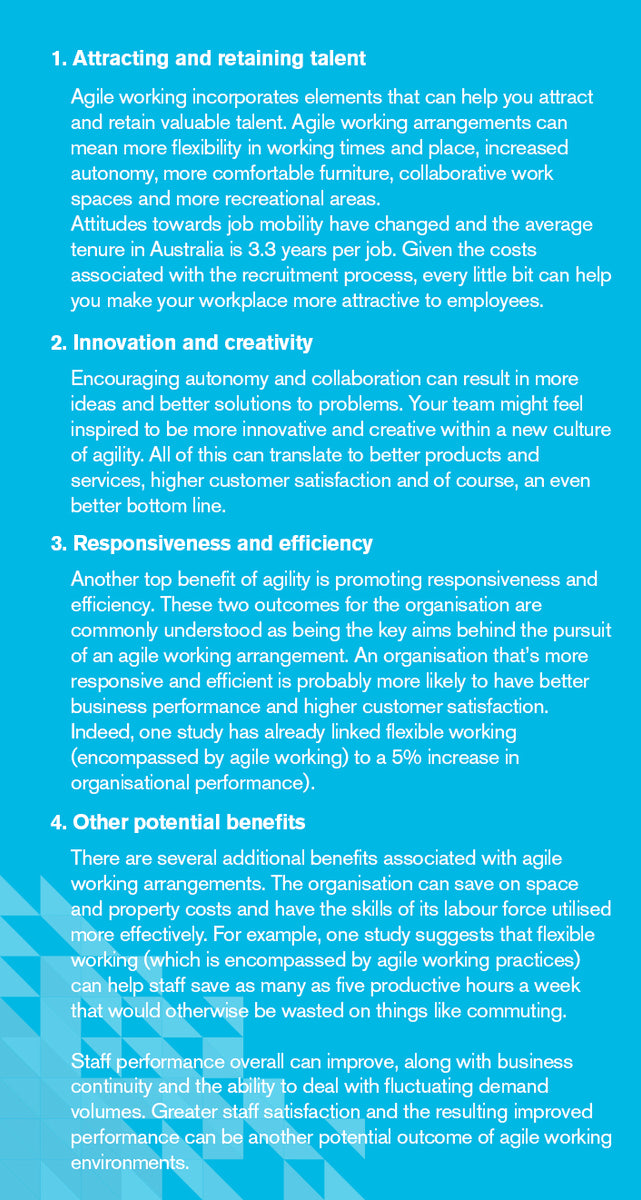What is Agile Working?
January 06, 17

The concept of agile working has been around for at least five years or more, but attempts to define it are often hazy and vague. What's clear about agile working is that organisations are increasingly looking to it as a way to improve business performance and enhance employees' working effectiveness. Agile working goes beyond flexible working to encompass new and efficient work arrangements.
Elements of agile working
Agile working is characterised by a multidimensional approach to rethinking work: this transformational approach addresses performance and outcomes and rethinks everything from time and location to roles and sources of work (who does the work). It's helpful to think about how agile working differs from flexible working, as this can allow us to better understand what being agile in the workplace truly means. According to some experts, agile working encompasses flexible working and adds a third dimension to the flexibility associated with time and place under flexible working arrangements:- Flexible working - Flexible working involves having employees work at non-traditional times and places, typically to enhance productivity and work-life balance. Examples include flexitime, telecommuting, and so on.
- Autonomy - Agile working differs from flexible working with a third key element - autonomy. Employees choose how they want to work to meet the performance goals and standards that are set by managers. They may be constrained by compliance and other limits, but generally they have free rein to hit targets in a way that they choose. As experts point out, some roles will lend themselves better to autonomous working arrangements than others.
Creating a more effective organisation
The ultimate goal of agile working is increased efficiency. The idea is that by providing your staffing team with greater autonomy in not only when and where they work but also how, you can enhance responsiveness, efficiency and effectiveness across the business. In turn, this leads to business performance improvements, heightened product and/or service quality, and increased customer satisfaction. The agile organisation could be said to have a culture of agility, which can mean it easily changes routines without excessive resistance, whilst staff and management are strongly committed to working in an agile manner.Agility in the physical space
Major brands such as the Commonwealth Bank, ASB Bank, and Atlassian are already taking steps to introduce more agile working spaces into their organisations. Other brands like Amazon and Spotify have already seen success by adopting the agile model to improve how they work. Agile working environments reflect the activity-centricity of agile working. Rather than focusing on work functions, roles and departments, the physical working environment is designed to facilitate this activity based working. Offices and spaces are flexible and adaptable enough to accommodate different types of working arrangements that can change from day to day. An agile working space is designed so that individuals can work by themselves and concentrate fully, or work effectively in small and large groups. There might be 'focus spaces' along with spaces for collaboration, team meeting, phone conversations, relaxation, concentration and inspiration. Some define agile working spaces quite specifically, suggesting that it's about optimising the work space by using a non-assigned seating model. There's also a cost-saving element to it. Because more than half of traditional workspaces are left unused each day, an agile approach to physical space can increase the efficient use of spaces while at the same time enhancing productivity and collaboration.Benefits of agile working
The touted benefits of agile working are numerous and can include retaining talent, enhancing a collaborative culture and boosting productivity. When implemented successfully, agile working arrangements can benefit both employee satisfaction and organisational performance. In order to achieve the best results from adopting an agile workplace, and to understand what benefits are likely to be applicable to your organisation, it's essential that you first work out what the goal to be achieved is. After all, how can you measure success if you don't have any metrics to which you can compare?
In order to achieve the best results from adopting an agile workplace, and to understand what benefits are likely to be applicable to your organisation, it's essential that you first work out what the goal to be achieved is. After all, how can you measure success if you don't have any metrics to which you can compare?
Enablers and challenges
One major challenge will probably be the cultural change in your organisation, as you're essentially effecting a change that requires people to rethink how they do their jobs on many different levels. Other challenges or barriers may include inconsistent quality of work, enforcing fair policies across all staffing levels, recruiting and training non-permanent staff, employee disengagement and difficulties in managing performance. There will likely be resistance from employees who might be used to a more rigid, fixed way of doing things, but if you can sell the change and obtain buy-in, these resistant employees could end up going on a path of discovery. The change can allow them to learn new and innovative ways of working that are more fulfilling and productive. Focus on empowering employees rather than forcing them to change, and make sure you have approval from senior management. Without consent from the leadership, it's difficult to make the cultural change on a scale that will benefit the organisation and its strategic vision. If your organisation and its leadership are reluctant to invest in renovations, this can also pose a challenge. Ensure that you're able to invest the necessary funds to create the types of new collaborative spaces you'll need to have. To succeed, recruit people who will champion the cause throughout the organisation, workout your space utilisation levels and seek help from outside experts such as consultants if necessary.Technology tools in agile working environments
Technology is a great enabler of agile working strategies. The right tools allow you to obtain space utilisation data and gather other data for your move. For example, badge swipe data lets you see how spaces are being used by looking at security and entry-exit information. Other tools such as sensors, Bluetooth, lighting sensors and desk sensors can also help you find out more about space usage requirements. Workplace management software can help you aggregate this data and understand it more effectively.


 Australia / New Zealand
Australia / New Zealand